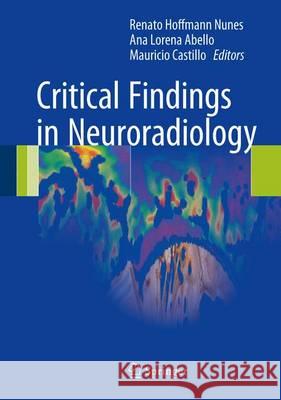Critical Findings in Neuroradiology » książka



Critical Findings in Neuroradiology
ISBN-13: 9783319279855 / Angielski / Twarda / 2016 / 535 str.
Critical Findings in Neuroradiology
ISBN-13: 9783319279855 / Angielski / Twarda / 2016 / 535 str.
(netto: 653,27 VAT: 5%)
Najniższa cena z 30 dni: 655,41 zł
ok. 22 dni roboczych
Bez gwarancji dostawy przed świętami
Darmowa dostawa!
This book provides clear guidance as to which neuroradiological findings in ill or injured patients should be immediately communicated by radiologists and trainees to the emergency room and referring physicians in order to facilitate key decisions and eliminate preventable errors.
"Critical Findings in Neuroradiology consists of 59 case-based review articles on important conditions and disease processes encountered in brain, head and neck, and spinal imaging. ... The book is targeted at radiologists in training, aimed at explaining what to look for and how to communicate findings to clinicians in an emergency setting. ... a useful collection of review articles on an extensive range of acute conditions and would be a useful reference for those trainees revising for their final examinations." (Dr. Mark Igra, RAD Magazine, December, 2016)
Part I – Adult Brain
1. Pneumocephalus including tension pneumocephalus
2. Epidural hematoma
3. Subdural hematoma
4. Extra axial hygromas and other fluid collections
5. Intracerebral hemorrhage
6. Intracerebellar hemorrhage
7. Active Bleeding as seen by the “spot and swirl signs”
8. Subarachnoid Hemorrhage and aneurysms
9. Vascular Malformations
10. Venous Thrombosis
11. Dural Fistula
12. Ischemic Stroke
13. Vascular Dissection
14. Brain Death
15. Mass Effect and Brain Herniations
16. Cerebral Edema
17. Meningitis, Empyema and Brain Abscess
18. Herpes encephalitis
19. Retained Foreign Body
20. Sinking Skin-Flap Syndrome
21. Intracranial hypotension
Part II – Adult Spine
22. Spinal Cord Infarct
23. Hemorrhage: extra medullary, extradural, and intramedullary
24. Spinal Dural Fistula
25. Spinal Cord Compression
26.
Traumatic spinal cord injuries27. Spinal Ligamentous Injury
28. Acute vertebral traumatic fractures
29. Acute pathologic vertebral fractures
30. Misplaced Hardware
Part III – Adult Head and Neck
31. Intraocular Hematoma - Orbital Injury
32. Penetrating Trauma
33. Airway Compromise
34. Lemiere Syndrome
35. Ludwig’s angiomas
36. External Malignant Otitis
37.
Extracranial artery dissections38. Laryngeal fracture
39.
Invasive Fungal Sinusitis40. Apical petrositis.
Part IV – Pediatric Brain
1. Skull fractures
2. Extra axial fluid collections
3. Child abuse
4. Intraparenchymal hemorrhage
5. Venous Thrombosis
6. Ischemic Stroke
7. Hypoxic - ischemic Injury<
8. Mass Effect and Brain Herniations
9. Meningitis, Empyema and Brain Abscess
10. Hydrocephalus and Shunt Malfunction
11. Posterior fossa tumors with acute hydrocephalus
Part V: - Pediatric Spine12. SCIWORA including spinal Cord Infarct
13. Hemorrhage: extra medullary, extradural, and intramedullary
14. Spinal Cord Compression
15. Acute vertebral fractures
16. Ligament spine injuries
Part VI – Pediatric Head and Neck
17. Epiglottitis
18. Retropharyngeal Abscess
19. Pre septal orbital cellulitis
20. Post septal orbital cellulitis
41. Temporal bone infections including Bezold abscess.
Dr. Nunes received his training in Diagnostic Radiology at the Federal University of Sao Paulo followed by a 2-year Neuroradiology fellowship at Santa Casa de Misericordia de Sao Paulo. He also spent 1 year as a Visiting Scholar at the University of North Carolina at Chapel Hill. Currently, he is a practicing neuroradiologist at Fleury Medicina e Saude and Residency Program Coordinator at Santa Casa de Misericordia de Sao Paulo, Sao Paulo, Brazil. He is also a board member of Sociedade Paulista de Radiologia (SPR).
Dr. Abello is a practicing neuroradiologist and a Professor of Radiology at the University del Valle in Cali, Colombia. She also spent 2 years as a Visiting Scholar at the University of North Carolina in Chapel Hill.
Dr. Mauricio Castillo is Professor of Radiology, Chief and Program Director of Neuroradiology and a Fellow of the American College of Radiology. His areas of interest include pediatric neuroimaging, application of new imaging techniques and medical literature editing. Dr. Castillo is the author or co-author of over 550 original and invited articles and 17 books. In the past, he has served as a member of the editorial boards of 11 journals, an article reviewer for 27 journals and since 2007, has been editor-in-chief for the American Journal of Neuroradiology, the most important journal in clinical neuroimaging.
Dr. Castillo has served as Secretary for the ASSR and has held several prominent positions in their Executive, Public Relations, Program Directors and Research Committees. He is a founding member of the American Society of Pediatric Neuroradiology (ASPNR) and served as Chair of its Research Committee and Education Committee. For the American Roentgen Ray Society (ARRS), he is Chair of the International Outreach committee and a member of the Executive Council. He chairs the Meetings Committee for the new ACR/ARRS initiative, where he is a member of five other committees.iv>
This book provides clear guidance as to which neuroradiological findings in ill or injured patients should be immediately communicated by radiologists and trainees to the emergency room and referring physicians in order to facilitate key decisions and eliminate preventable errors. It offers a practical and illustrative approach that identifies what to look for and how to report it and describes the required follow-up and the most common differential diagnoses of the main critical findings in neuroradiology. The book is distinctive in being written from a “critical findings perspective”, which makes its content more practical and memorable than that of a standard Emergency Neuroradiology textbook. It also illustrates the value of developing algorithmic approaches to report and communicate critical findings based on lists. While the book will appeal to a broad and variable audience, it is especially addressed to radiology training programs and will be a “must read” for residents and fellows in training.
1997-2025 DolnySlask.com Agencja Internetowa
KrainaKsiazek.PL - Księgarnia Internetowa









